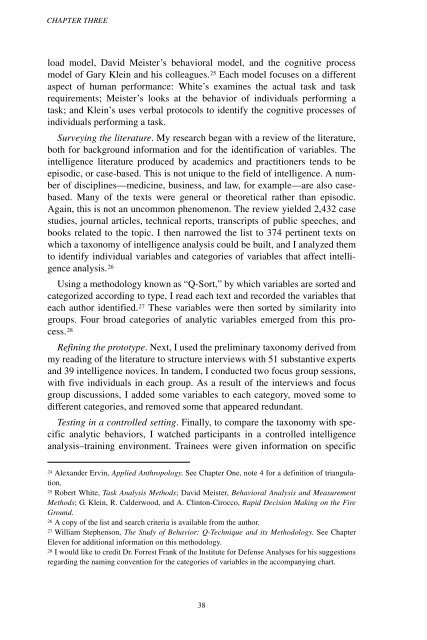Analytic Culture in the U.S. Intelligence Community (PDF) - CIA
Analytic Culture in the U.S. Intelligence Community (PDF) - CIA
Analytic Culture in the U.S. Intelligence Community (PDF) - CIA
You also want an ePaper? Increase the reach of your titles
YUMPU automatically turns print PDFs into web optimized ePapers that Google loves.
CHAPTER THREE<br />
load model, David Meister’s behavioral model, and <strong>the</strong> cognitive process<br />
model of Gary Kle<strong>in</strong> and his colleagues. 25 Each model focuses on a different<br />
aspect of human performance: White’s exam<strong>in</strong>es <strong>the</strong> actual task and task<br />
requirements; Meister’s looks at <strong>the</strong> behavior of <strong>in</strong>dividuals perform<strong>in</strong>g a<br />
task; and Kle<strong>in</strong>’s uses verbal protocols to identify <strong>the</strong> cognitive processes of<br />
<strong>in</strong>dividuals perform<strong>in</strong>g a task.<br />
Survey<strong>in</strong>g <strong>the</strong> literature. My research began with a review of <strong>the</strong> literature,<br />
both for background <strong>in</strong>formation and for <strong>the</strong> identification of variables. The<br />
<strong>in</strong>telligence literature produced by academics and practitioners tends to be<br />
episodic, or case-based. This is not unique to <strong>the</strong> field of <strong>in</strong>telligence. A number<br />
of discipl<strong>in</strong>es—medic<strong>in</strong>e, bus<strong>in</strong>ess, and law, for example—are also casebased.<br />
Many of <strong>the</strong> texts were general or <strong>the</strong>oretical ra<strong>the</strong>r than episodic.<br />
Aga<strong>in</strong>, this is not an uncommon phenomenon. The review yielded 2,432 case<br />
studies, journal articles, technical reports, transcripts of public speeches, and<br />
books related to <strong>the</strong> topic. I <strong>the</strong>n narrowed <strong>the</strong> list to 374 pert<strong>in</strong>ent texts on<br />
which a taxonomy of <strong>in</strong>telligence analysis could be built, and I analyzed <strong>the</strong>m<br />
to identify <strong>in</strong>dividual variables and categories of variables that affect <strong>in</strong>telligence<br />
analysis. 26<br />
Us<strong>in</strong>g a methodology known as “Q-Sort,” by which variables are sorted and<br />
categorized accord<strong>in</strong>g to type, I read each text and recorded <strong>the</strong> variables that<br />
each author identified. 27 These variables were <strong>the</strong>n sorted by similarity <strong>in</strong>to<br />
groups. Four broad categories of analytic variables emerged from this process.<br />
28<br />
Ref<strong>in</strong><strong>in</strong>g <strong>the</strong> prototype. Next, I used <strong>the</strong> prelim<strong>in</strong>ary taxonomy derived from<br />
my read<strong>in</strong>g of <strong>the</strong> literature to structure <strong>in</strong>terviews with 51 substantive experts<br />
and 39 <strong>in</strong>telligence novices. In tandem, I conducted two focus group sessions,<br />
with five <strong>in</strong>dividuals <strong>in</strong> each group. As a result of <strong>the</strong> <strong>in</strong>terviews and focus<br />
group discussions, I added some variables to each category, moved some to<br />
different categories, and removed some that appeared redundant.<br />
Test<strong>in</strong>g <strong>in</strong> a controlled sett<strong>in</strong>g. F<strong>in</strong>ally, to compare <strong>the</strong> taxonomy with specific<br />
analytic behaviors, I watched participants <strong>in</strong> a controlled <strong>in</strong>telligence<br />
analysis–tra<strong>in</strong><strong>in</strong>g environment. Tra<strong>in</strong>ees were given <strong>in</strong>formation on specific<br />
24<br />
Alexander Erv<strong>in</strong>, Applied Anthropology. See Chapter One, note 4 for a def<strong>in</strong>ition of triangulation.<br />
25<br />
Robert White, Task Analysis Methods; David Meister, Behavioral Analysis and Measurement<br />
Methods; G. Kle<strong>in</strong>, R. Calderwood, and A. Cl<strong>in</strong>ton-Cirocco, Rapid Decision Mak<strong>in</strong>g on <strong>the</strong> Fire<br />
Ground.<br />
26<br />
A copy of <strong>the</strong> list and search criteria is available from <strong>the</strong> author.<br />
27<br />
William Stephenson, The Study of Behavior: Q-Technique and its Methodology. See Chapter<br />
Eleven for additional <strong>in</strong>formation on this methodology.<br />
28<br />
I would like to credit Dr. Forrest Frank of <strong>the</strong> Institute for Defense Analyses for his suggestions<br />
regard<strong>in</strong>g <strong>the</strong> nam<strong>in</strong>g convention for <strong>the</strong> categories of variables <strong>in</strong> <strong>the</strong> accompany<strong>in</strong>g chart.<br />
38
















